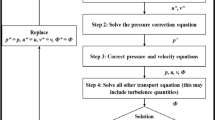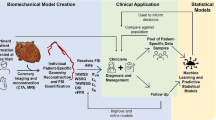Abstract
When conducting endovascular interventional surgery, doctors usually experience high viscous resistance resulting from direct contact with blood when operating the guide wire in blood vessels, which reduces the operational efficiency. Improper operation can cause vascular injuries and greatly reduce surgical safety, sometimes leading to the death of the patient. This paper presents a new method that applies transverse microvibrations at the proximal end of a conventional passive guide wire to reduce viscous resistance. The effect of the proposed method in reducing the viscous resistance in the fluid is studied. The influences of the tube diameter, medium density, and applied vibration frequency on the viscous force are investigated. Finally, for endovascular therapy, a mathematical model of the viscous force of the guide wire based on the proposed method is established in the environment of human blood vessels to predict the magnitude of the viscous force exerted on the guide wire and analyze the drag reduction effect of the proposed method. The effectiveness of the proposed method in drag reduction and its feasibility in improving surgical safety are experimentally demonstrated. The experimental results indicate that the proposed method can assist the doctor during complicated and variable operation conditions.










Similar content being viewed by others
References
T. Alderliesten, M.K. Konings, W.J. Niessen, Modeling friction, intrinsic curvature, and rotation of guide wires for simulation of minimally invasive vascular interventions. IEEE Trans. Biomed. Eng. 54(1), 29–38 (2007)
V.I. Babitsky, A.V. Mitrofanov, V.V. Silberschmidt, Ultrasonically-assisted turning of aviation materials: Simulations and experimental study. J. Mater, Process. Tech. 132(1–3), 157–167 (2003)
X. Bao, S. Guo, N. Xiao, Y. Li, Y. Cheng, Y. Jiang, A Cooperation of Catheters and Guidewires-based Novel Remote-Controlled Vascular Interventional Robot. Biomedical Microdevices 20(1) (2018a). https://doi.org/10.1007/s10544-018-0261-0
X. Bao, S. Guo, N. Xiao, Y. Li, Y. Cheng, R. Shen, J. Cui, Y. Jiang, X. Liu, K. Liu, in press. “Operation evaluation in-human of a novel remote-controlled vascular interventional robot”, biomedical microdevices (2018b)
R. Carmeli, J. Einav, and I. Yonat, “Device and method for opening vascular obstructions,” U. S. Patent 0 302 820, (2012)
M. Z. Cheng, “Viscous Fluid Dynamics Fundamentals,” in Viscous hydrodynamic basis, Higher Education Press, pp. 13–17 (1993)
G. Cloutier, J. Mayer, A.V. Phan, Singular function representation in obtaining closed-form solution to workpiece deflection in turning multi-diameter bars. Comput. Model. Simulat. Eng. 4, 133–137 (1999)
M. A. Evans et al., “Apparatus and method for removing occlusive material within blood vessels,” W.O. Patent 0 971 22 A2, (2003)
S. Guo et al., “A novel vibrating device for the interventional surgical Robotic System,” in Proc. IEEE Int. Conf. Mechatronics and Automation, Takamatsu, Japan, pp. 496–500, (2017)
J. Guo, X. Jin, S. Guo, Study of the Operational Safety of a Vascular Interventional Surgical Robotic System. Micromachines 9(3) (2018a). https://doi.org/10.3390/mi9030119
S. Guo, Y. Wang, N. Xiao, Y. Li, Y. Jiang, in press. “Study on real-time force feedback with a master-slave interventional surgical robotic system”, biomedical microdevices (2018b)
K. Igari et al., A novel approach to infrainguinal arteries with chronic total occlusions using the high frequency vibrational device. Int. Angiol. 35(2), 212–216 (2016)
M. Khoshnam, R.V. Patel, “A Pseudo-Rigid-Body 3R Model for a Steerable Ablation Catheter”, in Proc (IEEE Int. Conf. Robot. Autom, Karlsruhe, Germany, 2013), pp. 4412–4417
T.M. Khoshnam, A. Skanes, R. Patel, Modeling and estimation of tip contact force for steerable ablation catheters. IEEE Trans. Biomed. Eng. 62(5), 1404–1415 (2015)
G.D. Kim, B.G. Loh, An ultrasonic elliptical vibration cutting device for micro V-groove machining: Kinematical analysis and micro V-groove machining characteristics. J. Mater, Process. Tech. 190(1–3), 181–188 (2007)
J. Laird et al., Recanalization of infrainguinal chronic total occlusions with the crosser system: Results of the PATRIOT trial. J. Invasiv. Cardiol. 26(10), 497–504 (2014)
G. Melzi et al., A novel approach to chronic total occlusions: The crosser system. Catheter. Cardiovasc. Interv. 68(1), 29–35 (2006)
J. E. Nash et al., “Thrombectomy and soft debris removal device,” U.S. Patent 0145 259 A1, (2011)
A. Pansky, “Device for traversing vessel occlusions and method of use,” U.S. Patent 0 196 348 A1, (2011)
A. Pansky, O. Weizman, and A. Melamud, “Method and device for recanalization of total occlusions,” U.S. Patent 0 292 296 A1, (2009)
A. Qi, and C. Du, “Fluid mechanics,” in Mechanics, 3nd ed., Higher Education Press, pp. 304–310, (1993)
H. Rafii-Tari, C.J. Payne, G.-Z. Yang, Current and emerging robot-assisted endovascular catheterization technologies: A review. Ann. Biomed. Eng. 42(4), 697–715 (2014)
A. Sakes et al., Treating Total occlusions: Applying force for recanalization. IEEE Rev. Biomed. Eng. 9, 192–207 (2016)
W. Tang et al., A stable and real-time nonlinear elastic approach to simulating guidewire and catheter insertions based on Cosserat rod. IEEE Trans. Biomed. Eng. 59(8), 2211–2218 (2012)
S. Yalonetsky et al., Chronic Total Occlusions. A Guide to Recanalization, 2nd Ed (Wiley, Hoboken, NJ, USA, 2013)
T. Zander et al., Infrainguinal revascularization using the crosser vibrational system. Minim Invasiv. Ther. Allied. Technol. 19(4), 231–236 (2010)
C. Zhang et al., “Effects of the transverse micro-vibration on guide wires for endovascular therapy,” in Proc. IEEE Int. Conf. Mechatronics and Automation, Takamatsu, Japan, pp. 491–495, (2017)
Linshuai Zhang, Shuxiang Guo, Huadong Yu, Yu Song, Takashi Tamiya, Hideyuki Hirata, Hidenori Ishihara, “Design and performance evaluation of collision protection-based safety operation for a haptic robot-assisted catheter operating system”, Biomedical Microdevices, Vol. 20, No. 2, https://doi.org/10.1007/s10544-018-0266-8, (2018)
Y. Zhao, S. Guo, N. Xiao, Y. Wang, Y. Li, Y. Jiang, in press. “Operating force information on-line Acquisition of a Novel Slave Manipulator for vascular interventional surgery”, biomedical microdevices (2018)
Acknowledgements
This research was supported by the National High-tech Research and Development Program (863 Program) of China (2015AA043202) and the National Key Research and Development Program of China (2017YFB1304401).
Author information
Authors and Affiliations
Corresponding authors
Rights and permissions
About this article
Cite this article
Zhang, C., Guo, S., Xiao, N. et al. Transverse microvibrations-based guide wires drag reduction evaluation for endovascular interventional application. Biomed Microdevices 20, 69 (2018). https://doi.org/10.1007/s10544-018-0315-3
Published:
DOI: https://doi.org/10.1007/s10544-018-0315-3




